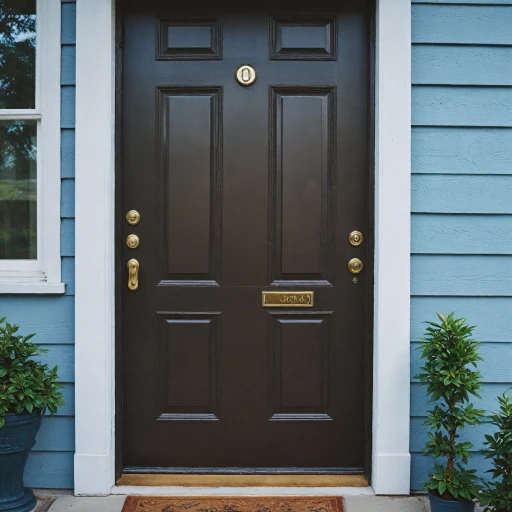What is a Doorbell Transformer?
A doorbell transformer is an often overlooked, yet pivotal component in traditional and modern doorbell systems. Essentially, it serves to convert the high voltage from your household electrical system, typically around 120 volts, to a lower voltage suitable for doorbells. This step down is crucial because most doorbells, especially the wired ones, operate on low voltage, usually between 16 to 24 volts.
The transformer is typically housed in a small, unassuming box, often found tucked away in obscure locations like basements, garages, or utility rooms. These transformers are vital for ensuring your doorbell, whether a basic chime or an advanced video doorbell, receives the correct voltage to function properly without any risk of damage due to power surges.
While the installation of a doorbell transformer might require a bit of electrical know-how, familiarizing oneself with its function can be beneficial. Not only does it allow homeowners to perform simple troubleshooting, but it also assists in making informed decisions when upgrading to smart doorbells which may have different power requirements.
Checking the transformer’s compatibility with your intended doorbell system is vital. For example, a video doorbell pro may demand specific power supply configurations. Understanding the compatibility and ensuring you have a transformer compatible with your setup minimizes potential issues after installation.
The market is replete with transformer options ranging from brands like Newhouse Hardware to budget-friendly options on retail websites like Amazon. Careful consideration of current price, reviews, and product stars can guide you in selecting the right transformer.
For those considering a wired doorbell, ensuring a solid power supply setup will prevent disruptions, maintaining an efficient and reliable door chime system within your home. Future installments and connections, such as advanced features in emerging doorbell technology, may also benefit from an upgraded transformer.
Compatibility with Smart Doorbells
Ensuring Compatibility with Modern Smart Doorbells
When it comes to installing smart doorbells, an essential component to consider is the doorbell transformer. Ensuring that the transformer is compatible with your smart doorbell is crucial for optimal performance. If you're wondering how to determine compatibility with popular models like Nest or other video doorbells, these tips should help you.- Voltage and Power Requirements: First, check the voltage and power requirements of your new video doorbell. Most smart systems have specific requirements that differ from traditional doorbells. The transformers typically need to provide a voltage ranging from 16 to 24 volts. Consult product reviews on retail sites like Amazon to gather user experiences about transformer performance.
- Evaluating Your Existing Transformer: Before proceeding, inspect your current doorbell transformer. The location is usually near the electrical panel or sometimes enclosed in a small box in the basement. Look for compatibility details on the transformer itself or in the manual.
- Wired vs. Wireless Models: Keep in mind that wired doorbells often require a stable power supply compatible with a chime transformer. Check if your system supports wired configurations or if you're using a battery-powered solution.
- Consider Current and Power Supply: Make sure that the electrical system can handle the power load. A doorbell transformer compatible with your video doorbell will ensure there's enough power supply without interruptions, especially when the doorbell chime and video capture are in simultaneous use.
- Feedback from Owners: Reading customer reviews and checking the current price can also provide insights into any compatibility issues experienced by other users. This information can guide you in making an informed purchase.
Installation Tips for Doorbell Transformers
Proper Steps for Installing Your Doorbell Transformer
When it comes to installing a doorbell transformer, particularly one compatible with smart doorbells like Nest or wired doorbells, there are several crucial steps to follow. Ensuring proper installation will not only help in achieving optimal performance but also in extending the life of your video doorbell system.
1. Choose the Right Location: Mounting the transformer near your existing electrical panel is typically recommended. This area often has the most accessible power supply, which simplifies installation logistics. Ensure the selected location remains dry and is easily reachable for future maintenance tasks.
2. Verify Voltage Compatibility: Before installation, checking that the transformer's voltage aligns with the requirements of your specific video doorbell model is critical. Most transformers, such as those from Newhouse Hardware and others found on platforms like Amazon, provide voltage ratings that should match your doorbell’s specifications, usually from 16 to 24 volts.
3. Connect Wiring to the Chime: Ensure the wiring from the transformer correctly connects to your door chime. This involves the proper handling of the doorbell wired system, including secure connections to the chime box. Be aware of the need for compatibility with any existing wiring systems; otherwise, reviews suggest potential performance issues or the risk of the door chime not functioning.
4. Test Before Finalizing Installation: After making connections, turn the power on to test the system. Verify that the doorbell push button activates the chime and video features properly. If issues arise, recheck connections, keeping in mind that transformer compatible aspects may differ among various video doorbell options.
For those looking to add additional features to their doorbell setup, incorporating a guide to adding a doorbell with professional-grade systems might offer an extended solution. For more comprehensive advice, check out this guide to adding a doorbell with HomePro.
Common Issues and Troubleshooting
Navigating Common Challenges and Solutions
When setting up a doorbell transformer for your smart doorbells, you might run into some typical issues. Here are some practical tips and troubleshooting steps to ensure your installation runs smoothly:- Voltage Mismatch: Ensure your transformer provides the correct voltage for your video doorbell. Most video doorbells, such as Nest or other reputed brands, require a specific voltage range, often between 16-24 volts. A mismatch in voltage could lead to malfunctioning or inadequate performance.
- Power Inconsistency: If the chime or the doorbell is not receiving power, first check the wiring connections. Ensure that wired connections from the transformer to the chime and doorbell are secure. A loose connection can often disrupt the power supply.
- Overheating Transformers: If the transformer is heating up excessively, consider the possibility of overloading due to additional video doorbells or chimes. In such situations, it might be necessary to upgrade the transformer to a higher capacity model. Checking product reviews or consulting with electrical experts might help you identify a transformer compatible with your current setup.
- Location Concerns: The transformer’s location can impact its efficiency. Verify that the transformer is installed in a ventilated area, away from potential moisture exposure, which could be behind the door or near a door chime.
- Compatibility with Wired Systems: Review the compatibility of the transformer with your existing wired doorbell system. Not all transformers are compatible with older chimes or push buttons, which can result in an integrated system that doesn't function as expected.
Upgrading Your Doorbell System
Enhancing Your Doorbell System
Upgrading your doorbell system can significantly enhance the security and convenience of your home. Whether you're looking to install a video doorbell or simply improve the existing setup, understanding the role of a doorbell transformer is crucial. A doorbell transformer is responsible for converting your home's high voltage into a lower voltage suitable for doorbells. This ensures that your video doorbell or chime operates efficiently.
When considering an upgrade, it's important to evaluate the compatibility of your current transformer with new devices. Many modern video doorbells, such as the Nest or other models available on Amazon, require specific voltage levels. Check the product specifications and reviews to ensure your transformer provides the necessary power supply.
For a seamless upgrade, consider the following steps:
- Assess the Current System: Determine if your existing doorbell transformer can support the voltage and power requirements of your new video doorbell.
- Choose the Right Transformer: Look for a transformer compatible with your chosen doorbell. Brands like Newhouse Hardware offer reliable options. Ensure the transformer can handle the electrical demands of a video doorbell.
- Installation: If you're replacing a wired doorbell, make sure to follow the installation tips to avoid common issues. Pay attention to the location of the transformer box and ensure it's accessible.
- Consider Future Needs: As technology evolves, consider doorbell transformers that can adapt to future upgrades, such as smart home integrations or advanced video features.
Upgrading your doorbell system not only improves security but also adds a modern touch to your home. With the right transformer and installation, you can enjoy the benefits of a reliable and efficient doorbell system.
Future Trends in Doorbell Technology
The Path Forward: Innovations and Emerging Trends in Doorbell Technology
Exploring the future of doorbell technology means diving into an exciting shift where advancements aim to enhance convenience, security, and integration with smart home ecosystems. As traditional doorbells continue to evolve, several trends are setting the stage for the next generation of this home essential.- Smart Doorbell Integration: The emphasis on integration with other smart devices is growing. Video doorbells are not merely standalone gadgets anymore; they are becoming part of an interconnected home system that includes smart locks, lighting, and thermostats, offering homeowners new levels of convenience and control.
- Wireless Power Solutions: While wired doorbell systems have been the norm, there’s a noticeable shift towards wireless power solutions. These solutions aim to eliminate the hassle of running wires and ensuring correct voltage and power needs, making installations more flexible and user-friendly without compromising on features.
- Enhanced Video Capabilities: Video quality in smart doorbells is seeing continuous improvements. With potential for higher resolution, wider field of view, and better night vision, these upgrades are designed to provide clearer and more reliable footage, crucial for security and monitoring purposes.
- AI and Cloud Technologies: Innovations in AI are poised to transform doorbell functionalities. From facial recognition to distinguishing between people, animals, and objects, these features promise to reduce false alerts and enhance security. Additionally, cloud storage solutions will likely become more robust, offering more comprehensive and secure video data management options.
- Sustainability and Eco-Friendly Designs: As environmental awareness grows, there’s a trend towards developing doorbell systems with sustainability in mind. This includes using eco-friendly materials in manufacturing, as well as optimizing power consumption to extend the lifespan of the device while minimizing its carbon footprint.
- Customization and Personalization: Consumers increasingly demand products that can be personalized to fit their lifestyle and home aesthetics. Future doorbells could offer more customization options, from chime sounds to faceplates, to match individual preferences.




